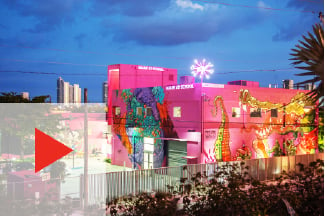
November 19, 2020
Balancing Preservation and Resiliency in Miami Beach
A group of architects, real estate experts, and preservationists discuss the unique challenges faced by Miami Beach.

During the 20th century, Miami Beach reinvented itself several times, from Gilded Age mecca, to Art Deco capital, to glamorous 1950s destination, only to become a faded has-been resort by the 1970s. The preservation movement that began in 1970s and 1980s became its saving grace. By the 1990s Miami Beach, especially its South Beach neighborhood, was one of the hippest communities in the United States, drawing notable European residents like Gianni Versace.
But throughout Miami Beach’s various metamorphoses, one thing never changed: It is a barrier island. “Since it’s a barrier island, the typical way of protecting an island—with dikes and seawalls—is not an option,” said Allan Shulman, FAIA, founding principal of Shulman + Associates and professor and director of graduate programs in Architecture at the University of Miami.
“Barrier islands are dynamic elements in the landscape,” said Susannah C. Drake, FASLA FAIA, Associate Professor, program in environmental design at the University of Colorado, Boulder and founding principal of dlandstudio. “They move and change and they’re on a bedrock that’s something like a sponge—it’s limestone. That’s a challenging set of criteria.”
With sea level rise inevitable, Shulman alluded to a study that put forth possible solutions to saving buildings from flooding, including raising floors and constructing “buildings within buildings,” allowing a structure to disengage from its shell. “The resilient layer we’re trying to build in Miami Beach often clashes with historic preservation,” Shulman continued. “We acknowledge that we have to challenge some of these standards.”
But these standards have a strong champion in Deborah Tackett, chief of historic preservation for the city of Miami Beach, who agrees that preservation must go beyond saving historic architecture.

“Miami Beach has always embraced evolution and change,” she said. “The city has to push developers and homeowners to take responsibility for their own properties, and we spend a lot of time harmonizing private property with city infrastructure.”
She continued: “We’re known for one thing—beauty, beautiful architecture and beautiful people. Let’s look at resiliency as an opportunity for drawing in more people.”
Drake put it in a nutshell: “We need to figure out a better way to live with water. We have to think about natural flows and how they can sync with human use of the places and human pleasure. Somehow we have to think more holistically about our relationship with the natural environment.”
Tackett agreed: “Doing nothing is not an option.”
The Think Tank discussions were held on October 1, 8, and 15. The conversations were presented in partnership with DesignTV, Material Bank, GROHE, and Durkan.









